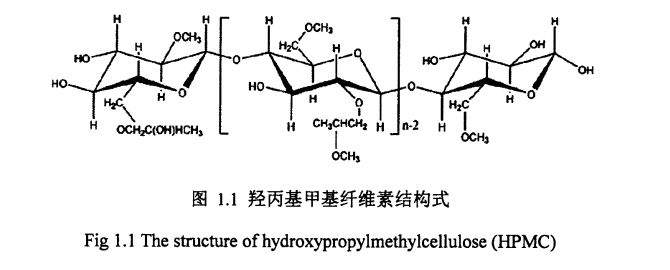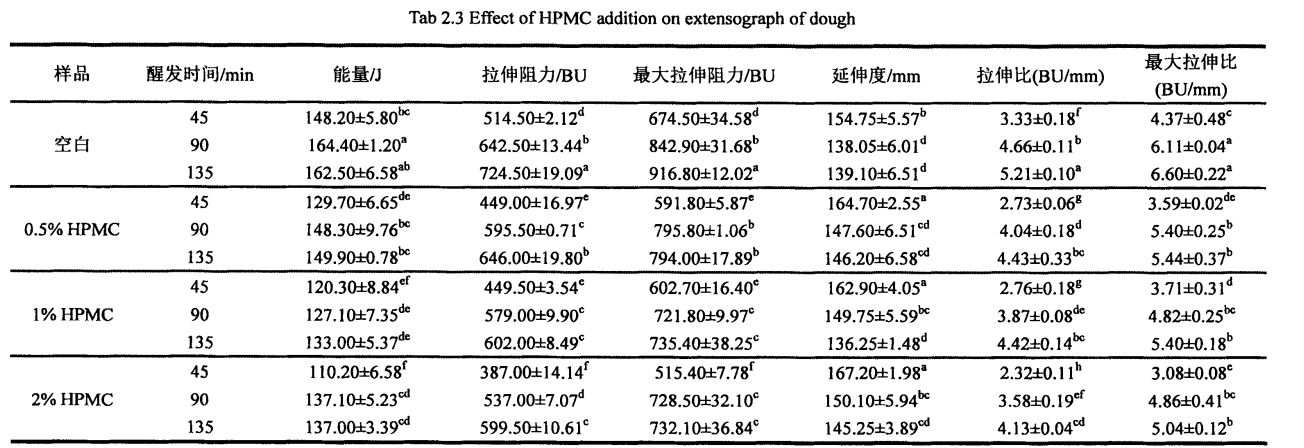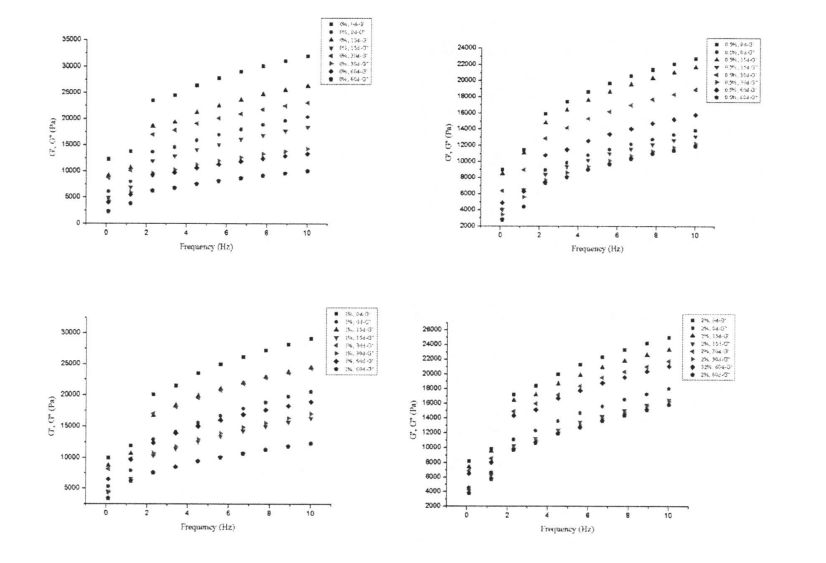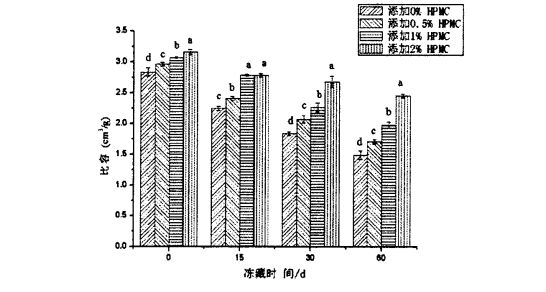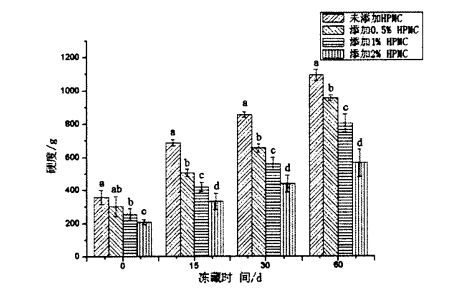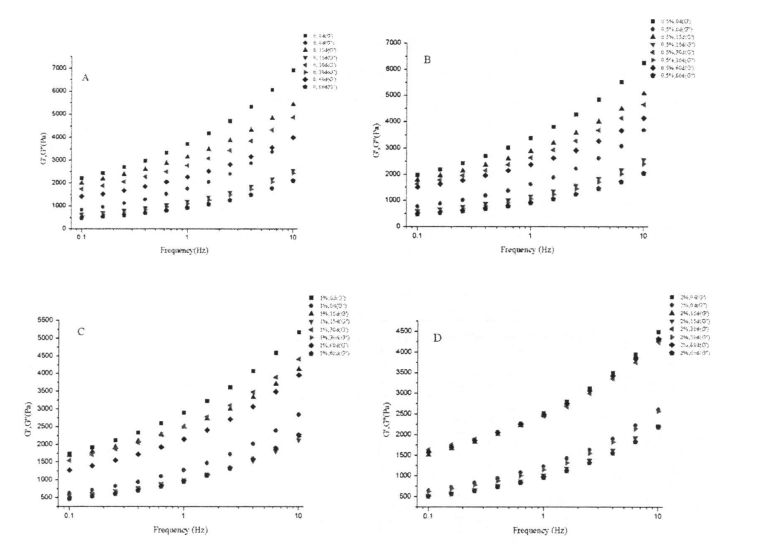The experimental results of farinality and stretching showed that the addition of HPMC improved the processing properties of the dough, and the dynamic frequency scanning results showed that the viscoelasticity of the dough added with HPMC during the freezing period changed little, and the dough network structure remained relatively stable. Intaa waxaa sii dheer, marka la barbar dhigo kooxda kantaroolka, mugga gaarka ah iyo bahalnimada kibirka la dubay ayaa la hagaajiyay, adkeynna waa la dhimay ka dib markii cajiinka qabow uu ku daray 2% HPMC ay qaboojisay 60 maalmood.
Gult Gluten waa astaanta astaanta qaab dhismeedka qaab dhismeedka shabakadda cajiinka. Experiments found that the addition of I--IPMC reduced the breakage of Yd and disulfide bonds between wheat gluten proteins during frozen storage. In addition, the results of low-field nuclear magnetic resonance and differential scanning the water state transition and recrystallization phenomena are limited, and the content of freezable water in the dough is reduced, thereby suppressing the effect of ice crystal growth on the gluten microstructure and its spatial conformation. Scanning electron microscope showed intuitively that the addition of HPMC could maintain the stability of gluten network structure.
1.1.3 Garaaca cajiinka barafka ah ee barafka ah ...........................................................................
1.1.7 Hydroxypropyl methyl cellulose (Hydroxypropyl methyl cellulose, I-IPMC) ………. 5
112 Ujeedada iyo muhiimadda daraasadda ...............................................................................
1.3 Waxyaabaha ugu weyn ee daraasadda .........................................................................
2.3 Experimental results and discussion…………………………………………………………………… . 11
2.3.2 Saamaynta ku darista HPMC ee hantida farqiga ee cajiibka ah ee cajiinka ................... .111111
2.4 Soo Koobid Cutubka cutubka .............................................................................................................
Cutubka 3 Saameynta DPMC
3.2.4 Qaababka tijaabada ah ................................................................................. 25
3. Natiijooyinka iyo doodda ..................................................................................................
3.3.2 The effect of adding amount of HPMC and freezing storage time on the freezable moisture content (CFW) and thermal stability……………………………………………………………………. 30
3.3.3 Effects of HPMC addition amount and freezing storage time on free sulfhydryl content (C vessel) …………………………………………………………………………………………………………. . 34
3.3.4 saamaynta Qaddarka isugeynta ee HPMC iyo waqtiga keydinta qaboojinta ee waqtiga nasashada (N) ee Gloten Gloten Naven ..................................................................................
3.3.7 saamaynta Qaddarka isugeynta ee HPMC iyo waqtiga kaydinta ee qaboojinta ee qaab dhismeedka shabakadda ee gluten ..........................................................................
3.4 Cutubka cutubka .................................................................................................................
4.1 Introduction .............................................................................................................................. . 44
4.2 Experimental materials and methods ................................................................................. 45
4.2.1 Qalabka tijaabada ah ..........................................................................................................
4.2.3 Habka Tijaabada ...............................................................................................
4.3 Analysis and discussion ........................................................................................................... 48
4.3.1 Content of basic components of wheat starch ……………………………………………………. 48
4.3.3 Effects of HPMC addition and freezing storage time on the shear viscosity of starch paste………………………………………………………………………………………………………………………………………. 52
4.3.5 Saamaynta Qaddarka isugeynta ee HPMC iyo waqtiga kaydinta ee qaboojiyaha ee istaarta bararka ................................................................................... .56
4.3.6 Effects of I-IPMC addition amount and frozen storage time on the thermodynamic properties of starch ………………………………………………………………………………………………………. . 57
Chapter 5 Effects of HPMC addition on yeast survival rate and fermentation activity under frozen storage conditions………………………………………………………………………………………………. . 62
5.1Introduction .................................................................................................................................... 62
5.2 Materials and methods ............................................................................................................ 62
5.2.1 Qalabka tijaabada ah iyo aaladaha .....................................................
5.2.2 Experimental methods . . . . . …………………………………………………………………………. 63
5.3 Results and Discussion ............................................................................................................... 64
5.3.3 The effect of adding amount of HPMC and freezing time on the content of glutathione in dough……………………………………………………………………………………………………………66. "
5.4 Chapter Summary ........................................................................................................................ 67
6.1 Conclusion ................................................................................................................................. . 68
6.2 Muuqaalka ................................................................................................................ 68
Figure 1.1 The structural formula of hydroxypropyl methylcellulose………………………. . 6
Jaantus 2.3 Saamaynta HPMC isugeynta HPMC iyo qaboojinta waqtiga adag ee rootiga la kariyey .................................................................................
Figure 2.4 The effect of HPMC addition and freezing time on the elasticity of steamed bread………………………………………………………………………………………………………………………………. . 20
Figure 3.1 The effect of HPMC addition and freezing time on the rheological properties of wet gluten…………………………………………………………………………………………………………………………. 30
Figure 3.2 Effects of HPMC addition and freezing time on the thermodynamic properties of wheat gluten………………………………………………………………………………………………………………. . 34
Figure 3.3 Effects of HPMC addition and freezing time on free sulfhydryl content of wheat gluten……………………………………………………………………………………………………………………………... . 35
Jaantus 3.7 Saameynta waqtiga isku darka iyo qaboojinta ee qaabdhismeedka shabakada mikroscopic gluten .............................................................................................................. 43
Figure 4.1 Starch gelatinization characteristic curve ............................................................... 51
Figure 4.2 Fluid thixotropy of starch paste ................................................................................. 52
Jaantusyada 4.3 Saameynta 57
Figure 4.5 Effects of HPMC addition and freezing storage time on the thermodynamic properties of starch…………………………………………………………………………………………………………. . 59
Figure 5.2 The effect of HPMC addition and freezing time on the yeast survival rate…………………………………………………………………………………………………………………………………... . 67
Figure 5.3 Microscopic observation of yeast (microscopic examination) …………………………………………………………………………………………………………………………. 68
Table 3.2 Effects of I-IPMC addition amount and freezing storage time on the phase transition enthalpy (Yi IV) and freezer water content (e chat) of wet gluten………………………. 31
Table 3.3 Effects of HPMC addition amount and freezing storage time on the peak temperature (product) of thermal denaturation of wheat gluten…………………………………………. 33
Table 3.6 Effects of I-IPMC addition and freezing storage time on the surface hydrophobicity of wheat gluten……………………………………………………………………………………………. 41
Table 4.3 Effects of I-IPMC addition and freezing time on the shear viscosity of wheat starch paste…………………………………………………………………………………………………………………………. 55
Steamed bread refers to the food made from the dough after proofing and steaming. Iyada oo ah cunno caan ah oo caan ah oo Shiinaha ah, rootiga la caseeyey wuxuu leeyahay taariikh dheer waxaana loo yaqaanaa "rootiga oriental". Because its finished product is hemispherical or elongated in shape, soft in taste, delicious in taste and rich in nutrients [l], it has been widely popular among the public for a long time. It is the staple food of our country, especially the northern residents. The consumption accounts for about 2/3 of the dietary structure of products in the north, and about 46% of the dietary structure of flour products in the country [21].
1) Horumarinta caleenta cusub ee la dubay. Through the innovation of steamed bread raw materials and the addition of functional active substances, new varieties of steamed breads have been developed, which have both nutrition and function. Established the evaluation standard for the quality of miscellaneous grain steamed bread by principal component analysis; Fu et a1. (2015) added lemon pomace containing dietary fiber and polyphenols to steamed bread, and evaluated the antioxidant activity of steamed bread; Hao & Beta (2012) studied barley bran and flaxseed (rich in bioactive substances) The production process of steamed bread [5]; Shiau et a1. (2015) evaluated the effect of adding pineapple pulp fiber on dough rheological properties and steamed bread quality [6].
3)Research on dough preparation and steamed bread making technology. Research on the influence of steamed bread production process conditions on its quality and process optimization; Liu Changhong et al. (2009) showed that in the process of dough conditioning, process parameters such as water addition, dough mixing time, and dough pH value have an impact on the whiteness value of steamed bread. It has a significant impact on sensory evaluation. If the process conditions are not suitable, it will cause the product to turn blue, dark or yellow. The research results show that during the dough preparation process, the amount of water added reaches 45%, and the dough mixing time is 5 minutes, ~ When the pH value of the dough was 6.5 for 10 min, the whiteness value and sensory evaluation of the steamed buns measured by the whiteness meter were the best. When rolling the dough 15-20 times at the same time, the dough is flaky, smooth, elastic and shiny surface; when the rolling ratio is 3:1, the dough sheet is shiny, and the whiteness of the steamed bread increases [l to; Li, et a1. (2015) explored the production process of compound fermented dough and its application in steamed bread processing [13].
4)Research on quality improvement of steamed bread. Research on the addition and application of steamed bread quality improvers; Inta badan oo ay ku jiraan waxyaabaha lagu daro (sida enzymes, enzymes, antioxidayaasha, iwm. the requirements of celiac disease (Dietary needs of patients with Coeliac Disease [16.1 cit.
7) Daraasad ku saabsan adeegsiga cajiinka barafka ah rooti la qaboojiyey.
a) Qaabka cajiinka ee qabow: Cajiinka ayaa loo qaybiyaa hal xabbadood, qabow, barafoobay, la qaboojiyey, la caddeeyo, oo la kariyey, dubista, iwm.)
c
The emergence of frozen dough not only creates conditions for the industrialization, standardization, and chain production of fermented pasta products, it can effectively shorten processing time, improve production efficiency, and reduce production time and labor costs. Therefore, the aging phenomenon of the pasta food is effectively inhibited, and the effect of prolonging the shelf life of the product is achieved. Sidaa darteed, gaar ahaan Yurub, Mareykanka, Japan iyo dalal kale, cajiinka la qaboojiyey ayaa si weyn loogu isticmaalaa rootiga cad (rootida macaan ee Faransiiska (muffins), rootiga rootiga (robers), baguette-ka Faransiiska (- kuliyada), buskudka iyo barafoobay
Most studies have found that the formation and growth of ice crystals in frozen foods is an important factor leading to the deterioration of product quality [291]. Ice crystals not only reduce the survival rate of yeast, but also weaken the gluten strength, affect the starch crystallinity and gel structure, and damage the yeast cells and release the reducing glutathione, which further reduces the gas holding capacity of gluten. In addition, in the case of frozen storage, temperature fluctuations can cause ice crystals to grow due to recrystallization [30]. Therefore, how to control the adverse effects of ice crystal formation and growth on starch, gluten and yeast is the key to solving the above problems, and it is also a hot research field and direction. Tobankii sano ee la soo dhaafay, baarayaal badan ayaa ku hawlanaa shaqadan waxayna gaareen natiijooyin cilmi baaris oo miro dhal ah. Si kastaba ha noqotee, wali waxaa jira waxyaabo yar yar iyo qaar ka mid ah arrimaha aan la xallin oo muran badan ku yimaadda arimahan, oo loo baahan yahay in si kale loo sahamiyo, sida:
a)How to restrain the quality deterioration of frozen dough with the extension of frozen storage time, especially how to control the influence of the formation and growth of ice crystals on the structure and properties of the three main components of dough (starch, gluten and yeast), is still an issue. Hotspots iyo arrimaha aasaasiga ah ee ku saabsan goobtan cilmi baarista;
b) maxaa yeelay waxaa jira kala duwanaansho gaar ah oo ku saabsan tikniyoolajiyadda iyo tikniyoolajiyadda wax soo saarka iyo qaacidada, wali waxaa jira cilmi baaris oo ku saabsan horumarinta cajiinka laxiriira ee ku habboon noocyada wax soo saarka ee kaladuwan;
1.1.5RESEarararch Cajiinka barafoobay
i.Study the changes in the structure and properties of frozen dough with the extension of freezing storage time, in order to explore the reasons for the deterioration of product quality, especially the effect of ice crystallization on biological macromolecules (protein, starch, etc.), for example, ice crystallization. Formation and growth and its relationship with water state and distribution; changes in wheat gluten protein structure, conformation and properties [31]; changes in starch structure and properties; Isbeddelka ku dhaca caanaha microkulka iyo guryaha la xiriira, iwm 361.
II. Kordhinta geedi socodka waxsoosaarka cajiinka ee barafka ah, xaaladaha kaydinta ee qaboojiyaha iyo caanobooraha. During the production of frozen dough, temperature control, proofing conditions, pre-freezing treatment, freezing rate, freezing conditions, moisture content, gluten protein content, and thawing methods will all affect the processing properties of frozen dough [37]. In general, higher freezing rates produce ice crystals that are smaller in size and more uniformly distributed, while lower freezing rates produce larger ice crystals that are not uniformly distributed. Intaas waxaa sii dheer, heerkulka qaboojiyaha hoose xitaa ka hooseeya heerkulka kala-guurka quraaradda (CTA) ayaa si wax ku ool ah u ilaalin kara tayadeeda, laakiin kharashka ayaa ka sareeya, waxsoosaarka gaagaaban iyo waxsoosaarka taraafikada iyo heerka qabowga ee silsiladda qabow badanaa waa yar yihiin. In addition, the fluctuation of the freezing temperature will cause recrystallization, which will affect the quality of the dough.
III. Using additives to improve the product quality of frozen dough. In order to improve the product quality of frozen dough, many researchers have made explorations from different perspectives, for example, improving the low temperature tolerance of material components in frozen dough, using additives to maintain the stability of the dough network structure [45.56], etc. Among them, the use of additives is an effective and widely used method. Mainly include, i) enzyme preparations, such as, transglutaminase, O [. Amylase; ii) emulsifiers, such as monoglyceride stearate, DATEM, SSL, CSL, DATEM, etc.; iii) antioxidants, ascorbic acid, etc.; iv) polysaccharide hydrocolloids, such as guar gum, yellow Originalgum, gum Arabic, konjac gum, sodium alginate, etc.; v) other functional substances, such as Xu, et a1. (2009) added Ice-structuring Proteins to wet gluten mass under freezing conditions, and studied its protective effect and mechanism on the structure and function of gluten protein [y71.
Si sax ah ayey u tahay sababta oo ah arjiga laxiriira ee cilmi baarista ee HPMC ee ku taal noodles-ka Shiinaha ayaa wali ah mid ka maqan. Sidaa darteed, ujeeddada tijaabadani waa in lagu ballaariyo arjiga HPMC ee cajiinka la qaboojiyey, iyo in la go'aamiyo hagaajinta cajiinka barafka ah ee ka baaraandega HPMC iyada oo loo marayo qiimeynta tayada rootida rootida. In addition, HPMC was added to the three main components of the dough (wheat protein, starch and yeast liquid), and the effect of HPMC on the structure and properties of wheat protein, starch and yeast was systematically studied. And explain its related mechanism problems, in order to provide a new feasible path for the quality improvement of frozen dough, so as to expand the application scope of HPMC in the food field, and to provide theoretical support for the actual production of frozen dough suitable for making steamed bread.
Guud ahaan marka loo eego, maaddada maaddada cajiinka loo isticmaalo samaynta badeecooyinka bur-jiifka ah (istaarijka, borotiinka, iyo khamiirka unugyada, iyo in ka dib isku xirnaanta iyo is-dhexgalka. A stable and complex material system with a special structure has been developed. Numerous studies have shown that the properties of the dough have a significant impact on the quality of the final product. Therefore, by optimizing the compounding to meet the specific product and it is a research direction to improve the dough formulation and technology of the quality of the product or food for use; on the other hand, improving or improving the properties of dough processing and preservation to ensure or improve the quality of the product is also an important research issue.
2.2 Qalabka tijaabada ah iyo qaababka
Zhongyu Wheat Flour Binzhou Zhongyu Food Co., Ltd.; Angel Active Dry Yeast Angel Yeast Co., Ltd.; Heerka HPMC (Methyl Beddelka 28% .30%, hydroxypropyl shahwada 7% .12%) Aladdin (Shanghai) shirkadda dib-u-celinta kiimikada; all chemical reagents used in this experiment are of analytical grade;
Magaca iyo magaca qalabka
Powder meter. Nadiifin
Extensometer. Nadiifin
Q200 Kala-goynta iskaanka kaladuwan ee Q200
FD. 1b. 50 Vasum Freezum Fange
Wax soo saare
Soosaarista Dhaqaalaha ee Guangdong ee Co., Ltd.
Brepender, Jarmalka
Brepender, Jarmalka
American ta shirkadaha
American ta shirkadaha
Beijing Bo Yi Kang tahtintation Coa., Ltd.
Shirkadda Deenishka Deenishka
2.2.3 Habka Tijaabada
Go'aaminta sifooyinka khafiifka ah ee cajiinka Sida uu qabo GB / T 14615.2006 [831.
Tixraac geedi socodka cajiinka sameynta ee GB / T 17320.1998 [84]. Weigh 450 g of flour and 5 g of active dry yeast into the bowl of the dough mixer, stir at low speed to fully mix the two, and then add 245 mL of low-temperature (Distilled water (pre-stored in the refrigerator at 4°C for 24 hours to inhibit the activity of yeast), first stir at low speed for 1 min, then at medium speed for 4 min until dough is formed. Take out the dough and divide it into about 180g / portion, knead it into a cylindrical shape, then seal it with a ziplock bag, and put it in. Freeze at 18°C for 15, 30, and 60 days. Add 0.5%, 1%, 2% (w/w, dry basis) HPMC to replace the corresponding proportion of flour quality to make dough, and the rest of the production methods remain unchanged. The 0-day frozen storage (unfrozen storage) was used as the control experimental group.
2.2.3.3 Nuxurka biyo nadiif ah oo biyo ah
Iyaga ka mid ah, 厶 wuxuu matalaa kuleylka qarsoon ee qoyaanka, qiimahooduna waa 334 J Danaha; MC (total Moisture Content) represents the total moisture content in the dough (measured according to GB 50093.2010t78]). Each sample was repeated three times.
2.2.3.7 Soosaarka rootida rootida
Ka dib wakhtiga qaboojinta ka dib, cajiinka la qaboojiyey ayaa la soo saaray, marka ugu horeysa si loo qiimeeyo 4 h, ka dibna lagu meeleeyo heerkulka qolka ilaa cajiinka barafoobay uu gebi ahaanba la qaboojiyey. Divide the dough into about 70 grams per portion, knead it into shape, and then put it into a constant temperature and humidity box, and proof it for 60 minutes at 30°C and a relative humidity of 85%. After proofing, steam for 20 min, and then cool for 1 h at room temperature to evaluate the quality of steamed bread.
Refer to the method of Sim, Noor Aziah, Cheng (2011) [88] with minor modifications. Sawirka aasaasiga ah ee 'MN'13 MN'13' MN'13 ee rootida la dubay ayaa laga jaray aagga dhexe ee rootiga la kariyey, iyo falanqaynta guud ee TPA (Falanqaynta Profile Plator) ee rootida la cadeeyo ayaa lagu cabiray tijaabada hantida jirka. Specific parameters: the probe is P/100, the pre-measurement rate is 1 mm/s, the mid-measurement rate is 1 mm/s, the post-measurement rate is 1 mm/s, the compression deformation variable is 50%, and the time interval between two compressions is 30 S, the trigger force is 5 g. Each sample was repeated 6 times.
All experiments were repeated at least three times unless otherwise specified, and the experimental results were expressed as the mean (Mean) ± standard deviation (Standard Deviation). Tirakoobka SPSS 19 waxaa loo adeegsaday falanqaynta kala duwanaanshaha (Falanqaynta kala duwanaanshaha, ANOVA), iyo heerka muhiimka ah ee muhiimka ah ayaa ahaa o. 05; Use Origin 8.0 to draw relevant charts.
Sifooyinka khafiifka ah ee cajiinka waxay sifiican uga tarjumi karaan howsha howsha cajiinka ka dib markii la caddeeyo, oo ay ku jiraan fiditaanka, iska caabbinta, iska caabbinta tobnaad ee cajiinka. The tensile properties of the dough are attributed to the extension of the glutenin molecules in the dough extensibility, as the cross-linking of glutenin molecular chains determines the elasticity of the dough [921]. Termonia, Smith (1987) [93] believed that the elongation of polymers depends on two chemical kinetic processes, that is, the breaking of secondary bonds between molecular chains and the deformation of cross-linked molecular chains. When the deformation rate of the molecular chain is relatively low, the molecular chain cannot sufficiently and quickly cope with the stress generated by the stretching of the molecular chain, which in turn leads to the breakage of the molecular chain, and the extension length of the molecular chain is also short. Only when the deformation rate of the molecular chain can ensure that the molecular chain can be deformed quickly and sufficiently, and the covalent bond nodes in the molecular chain will not be broken, the elongation of the polymer can be increased. Therefore, changing the deformation and elongation behavior of the gluten protein chain will have an impact on the tensile properties of the dough [92].
J (2% HPMC added). Isla mar ahaantaana, caabbinta ugu sareeya ee cajiinka ee cajiinka ayaa hoos u dhacay laga soo bilaabo 674.50-a: 34.58 - oo ku daraya 2.50-a (1%-a (20-a: 70-a (2% HPMC ayaa lagu daray). Si kastaba ha noqotee, meelaha cajiinka ah ayaa ka kordhay 154.75 + 7.57 Miti (maran) ilaa 164.70-a: 2.55-a Tan waxaa laga yaabaa inay sabab u tahay kororka maadooyinka-biyaha-balaastigga ah oo ku daraya HPMC, oo yareynaysa iska caabinta silsiladaha motecaulal ee glutc iyo gluten-ka ah ee ku dhaca in la kordhiyo cajiinka oo ay saameyn ku yeelanayso cajiinka, taas oo saameyn ku yeelan doonta tayada (tus. mugga, dhadhanka) ee sheyga ugu dambeeya.
2.3.5 Saameynta Lacagta isugeynta ee HPMC iyo waqtiga lagu keydiyo ee lagu keydiyo ee ku jira biyo-qaboojinta biyaha (ow) cajiinka qabow
2.3.6 saamaynta ee Iipmc isugeynta iyo waqtiga qaboojinta ee tayada rootida la dubay
Cabbirka gaarka ah ee rootiga la kariyey wuxuu sifiican uga tarjumi karaa muuqaalka iyo tayada dareenka ee rootida la dubay. The larger the specific volume of the steamed bread, the larger the volume of the steamed bread of the same quality, and the specific volume has a certain influence on the appearance, color, texture, and sensory evaluation of the food. Generally speaking, steamed buns with larger specific volume are also more popular with consumers to a certain extent.
Cabbirka gaarka ah ee rootiga la kariyey wuxuu sifiican uga tarjumi karaa muuqaalka iyo tayada dareenka ee rootida la dubay. The larger the specific volume of the steamed bread, the larger the volume of the steamed bread of the same quality, and the specific volume has a certain influence on the appearance, color, texture, and sensory evaluation of the food. Generally speaking, steamed buns with larger specific volume are also more popular with consumers to a certain extent.
2.3.6.2 saamaynta qaddarka isugeynta ee HPMC iyo waqtiga kaydinta ee qaboojiyaha ah ee ku saabsan astaamaha cuncunka ee rootiga la kariyey

On the other hand, with the prolongation of freezing time, the cohesion and restoring force of steamed bread decreased significantly. For steamed bread made from frozen dough without adding HPMC, its cohesion was increased by O. 86-4-0.03 g (frozen storage 0 days) was reduced to 0.49+0.06 g (frozen storage for 60 days), while the restoring force was reduced from 0.48+0.04 g (frozen storage for 0 days) to 0.17±0.01 (frozen storage for 0 days) 60 days); however, for steamed buns made from frozen dough with 2% HPMC added, the cohesion was reduced from 0.93+0.02 g (0 days frozen) to 0.61+0.07 g (frozen storage for 60 days), while the restoring force was reduced from 0.53+0.01 g (frozen storage for 0 days) to 0.27+4-0.02 (frozen storage for 60 days). Intaa waxaa sii dheer, oo ay ku dheehan tahay waqtiga lagu keydiyo ee qaboojiyaha, isku dhejinta iyo cunista rooti la qaboojiyey ayaa si aad ah kordhay. Wixii rootida la dubay laga sameeyay cajiinka la qaboojiyey oo aan ku darin HPMC, isku-dhegan ayaa kordhay 336.54 + 37. 24 (0 days of frozen storage) increased to 1232.86±67.67 (60 days of frozen storage), while chewiness increased from 325.76+34.64 (0 days of frozen storage) to 1005.83+83.95 (frozen for 60 days); however, for the steamed buns made from frozen dough with 2% HPMC added, the stickiness increased from 206.62+1 1.84 (frozen for 0 days) to 472.84. 96+45.58 (frozen storage for 60 days), while chewiness increased from 200.78+10.21 (frozen storage for 0 days) to 404.53+31.26 (frozen storage for 60 days). Tani waxay muujineysaa in ku darista HPMC ay si wax ku ool ah u horseedi karto isbedelada ku dhaca astaamaha dareeraha ee rootiga la kariyey ee ay sababaan kaydinta qaboojinta. In addition, the changes in the texture properties of steamed bread caused by freezing storage (such as the increase of stickiness and chewiness and the decrease of recovery force) There is also a certain internal correlation with the change of steamed bread specific volume. Thus, dough properties (eg, farinality, elongation, and rheological properties) can be improved by adding HPMC to frozen dough, and HPMC inhibits the formation, growth, and redistribution of ice crystals (recrystallization process), making frozen dough The quality of the processed steamed buns is improved.
2.4 Soo Koobid Cutubka Cutubka
Hydroxypropyl methylcellulose (HPMC) is a kind of hydrophilic colloid, and its application research in frozen dough with Chinese-style pasta food (such as steamed bread) as the final product is still lacking. The main purpose of this study is to evaluate the effect of HPMC improvement by investigating the effect of HPMC addition on the processing properties of frozen dough and the quality of steamed bread, so as to provide some theoretical support for the application of HPMC in steamed bread and other Chinese-style flour products. The results show that HPMC can improve the farinaceous properties of the dough. Marka lacagta lagu daro ee HPMC ay tahay 2%, heerka dhalmada ka soo nuugista biyaha ee cajiinka ayaa kordha 58.10% kooxda kontoroolka u ah kooxda 60.60%; 2 min increased to 12.2 min; at the same time, the dough formation time decreased from 2.1 min in the control group to 1.5 mill; Shahaadada daciifka ah ayaa hoos u dhacday 55 Furka kooxda kontaroolada ilaa 18 Fu. Intaas waxaa sii dheer, HPMC ayaa sidoo kale wanaajisay astaamaha khafiifka ah ee cajiinka. Iyada oo kororka qaddarka qaddarka HPMC ee uu raaciyay, wareegga cajiinka ayaa si aad ah u kordhay; si weyn hoos loogu dhigay. In addition, during the frozen storage period, the addition of HPMC reduced the increase rate of the freezable water content in the dough, thereby inhibiting the damage to the dough network structure caused by ice crystallization, maintaining the relative stability of the dough viscoelasticity and the integrity of the network structure, thereby improving the stability of the dough network structure. Tayada wax soo saarka ugu dambeeya ayaa la dammaanad qaadayaa.
3.1 Hordhac
Wheat gluten is the most abundant storage protein in wheat grains, accounting for more than 80% of the total protein. Marka loo eego jilicsanaanta qaybaha ay ka kooban tahay, waxaa loo qaybin karaa glutenin (lagu milmi karaa xalka alkaline) iyo gliadin (ku milma xalka alkaline). in ethanol solution). Waxaa ka mid ah, Miisaanka Moleculal (MW) ee Glutenin waa u sarreeysaa sida 1x107da, oo waxay leedahay laba hoosaadyo, taas oo sameyn karta bond bond bond-ka; In kasta oo culeyska molialal ee gliadin uu yahay 1x104da, oo waxaa jira hal judumit oo keliya, oo abuuri kara molaces denbi-denside-ka gudaha ah [100]. Campos, Steffe, & Ng (1 996) divided the formation of dough into two processes: energy input (mixing process with dough) and protein association (formation of dough network structure). It is generally believed that during dough formation, glutenin determines the elasticity and structural strength of the dough, while gliadin determines the viscosity and fluidity of the dough [102]. It can be seen that gluten protein has an indispensable and unique role in the formation of the dough network structure, and endows the dough with cohesion, viscoelasticity and water absorption.
Tirada iyo xasilloonida ayaa ka liidata sidii ay uqabsan yihiin dammaanad-celinta, laakiin waxay door muhiim ah ka ciyaaraan dayactirka isku xirnaanta Gluten [1041].
For frozen dough, under freezing conditions, the formation and growth of ice crystals (crystallization and recrystallization process) will cause the dough network structure to be physically squeezed, and its structural integrity will be destroyed, and microscopically. Accompanied by changes in the structure and properties of gluten protein [105'1061. As Zhao, et a1. (2012) found that with the prolongation of freezing time, the molecular weight and molecular gyration radius of gluten protein decreased [107J, which indicated that gluten protein partially depolymerized. In addition, the spatial conformational changes and thermodynamic properties of gluten protein will affect the dough processing properties and product quality. Sidaa darteed, inta lagu gudajiro hanaanka lagu keydiyo, waxaa muhiim ah in la baaro cilmi baaris gaar ah oo lagu baaro isbedelada gobolka biyaha (Scraftal Coast-ka) iyo qaab dhismeedka borotiinka gluten ee ku jira xaaladaha waqtiga kaydinta.
3.2 Qalabka iyo qaababka
Daahfurka. R3 Rheometer
722e Spectrophotometer
JSM. 6400lv Tungsten SPANTE SCANNGING Electronctope
Aniga. 5 Ultra-microelectronic balance
FD. 1b. 50 Vasum Freezum Fange
Thermo Fiser FC FC FC WEVE MARKA ISTICMAALO CODSIGII Akhriska Microplate
MYP ll. Nooca 2 walaaqa magnetic
Wax soo saare
American ta shirkadaha
American ta shirkadaha
Shanghai Spectrum aaladda Co., Ltd.
Warshadda Qalabka Jinni Jincheng Guossheng
Beijing Bo Yi Kang tahtintation Coa., Ltd.
Shirkadda Deenishka Deenishka
3.2.3 Regulayaal tijaabo ah
When the corresponding freezing time is over, take out the frozen wet gluten mass and place it in a 4°C refrigerator to equilibrate for 8 hours. Kadib, soo qaado muunadda oo ku rid heerkulka qolka illaa muunadda gabi ahaanba la dhalaaliyo (Qaabkan ee qaboojiyaha cufan ee qoyan ayaa sidoo kale lagu dabaqi karaa qayb ka mid ah tijaabooyinka, 2.7.1 iyo 2.9). Muunad (qiyaastii 2 g) ee aagga dhexe ee Gloten ee dhalaalaya ee dhalaalaya ayaa la jaray oo lagu meeleeyay muunada muunada (saxanka hoose) ee rherometer (Discovery R3). Strain Sweep) to determine the Linear Viscoelasticity Region (LVR), the specific experimental parameters are set as follows - the fixture is a parallel plate with a diameter of 40 mill, the gap is set to 1000 mrn, and the temperature is set to 25 °C, the strain scanning range is 0.01%. 100%, inta jeer ee loo qoondeeyay 1 Hz. Then, after changing the sample, let it stand for 10 minutes, and then perform dynamic
Frequency sweep, the specific experimental parameters are set as follows - the strain is 0.5% (at LVR), and the frequency sweep range is 0.1 Hz. 10 Hz, halka xubinta kale ay la mid yihiin sida xuduudaha xargaha. Scanning data is acquired in logarithmic mode, and 5 data points (plots) are recorded in the rheological curve for every 10-fold increase in frequency, so as to obtain the frequency as the abscissa, the storage modulus (G') and the loss modulus (G') is the rheological discrete curve of the ordinate. It is worth noting that after each time the sample is pressed by the clamp, the excess sample needs to be gently scraped with a blade, and a layer of paraffin oil is applied to the edge of the sample to prevent moisture during the experiment. of loss. Muunad kasta ayaa la soo saaray seddex jeer.
3.2.4.4 Go'aaminta guryaha thermodynamic
Sida ku xusan habka Bot (2003) [1081, kalorimitir iskaanka kaladuwan (DSC Q.200) ayaa loo adeegsaday tijaabadan si loo cabbiro astaamaha heerkulka heerkulka ee saamiga.
(1) Go'aaminta waxa ku jira biyo-qaboojiye ah (cf silicon) oo ku jira gluten qoyan
A 15 mg sample of wet gluten was weighed and sealed in an aluminum crucible (suitable for liquid samples). The determination procedure and parameters are as follows: equilibrate at 20°C for 5 min, then drop to .30°C at a rate of 10°C/min, keep the temperature for 10 min, and finally increase to 25°C at a rate of 5°C/min, purge the gas (Purge Gas) was nitrogen (N2) and its flow rate was 50 mL/min, and a blank sealed aluminum crucible was used as a reference. The-ka la helay ee shirkadda DSC waxaa lagu falanqeeyay iyadoo la adeegsanayo falanqaynta softiweerka ee safka ah ee falanqaynta guud ee 2000, iyadoo la eegaysa meelaha ugu sarreeya ee ku yaal 0 ° C. Integral to get the melting enthalpy of ice crystals (Yu day). Then, the freezable water content (CFW) is calculated by the following formula [85-86]:
Waxaa ka mid ah, saddex, waxay ka dhigan tahay kuleylka qarsoon ee qoyaanka, oo qiimahiisuna waa 334 J / G; MC waxay matalaysaa wadarta qoyaanka ah ee gululaatada qoyan ee lagu cabiro (waxaa lagu cabiray sida ku xusan GB 50093.2010 [. 78]). Each sample was replicated three times.
(2) Go'aaminta heerkulka ugu sarreeya ee dayactirka heerkulka (tp) ee borotiinka gluten
Dhexdooda, 73.53 waa furitaanka baabi'inta; A is the absorbance value; D waa qodobka dillaaca (1 halkan); G is the protein concentration. Muunad kasta ayaa la soo saaray seddex jeer.
3.2.4.6 Go'aaminta 1h I "" waqtiga nasashada
Among them, M is the function of the exponential decay sum of the signal amplitude with time (t) as the independent variable; Yang) waa shaqada nambarka lambarrada borotada hydrogen ee leh waqtiga nasashada (d) sida doorsoomaha madaxa-bannaan.
Adeegsiga joogtada ah ee algorithm-ka software-ka ku jira software-ka lagu dabaqayo isbadalka aan caadiga ahayn ee magaalada, isbadalka waxaa loo sameeyaa si loo helo qalooca isdaba-joogga ah. Muunad kasta ayaa lagu celiyay seddex jeer
3.2.4.7 Go'aaminta qaab dhismeedka labaad ee borotiinka gluten
In this experiment, a Fourier transform infrared spectrometer equipped with an attenuated single reflection attenuated total reflection (ATR) accessory was used to determine the secondary structure of gluten protein, and a cadmium mercury telluride crystal was used as the detector. Both sample and background collection were scanned 64 times with a resolution of 4 cm~ and a scanning range of 4000 cmq-500 cm~. Spread a small amount of protein solid powder on the surface of the diamond on the ATR fitting, and then, after 3 turns clockwise, you can start to collect the infrared spectrum signal of the sample, and finally get the wavenumber (Wavenumber, cm-1) as the abscissa, and absorbance as the abscissa. (Nuugista) waa muuqaalka shaashadda ee qarka u saaran.
3.2.4.4.8 Go'aaminta sadarka dusha sare ee borotiinka gluten
Sida ku xusan habka lootayo kato & Nakai (1980) [192],, Nafthalene sulfonic acid (AS) waxaa loo adeegsaday baaritaan si loo go'aamiyo biyaha dusha sare ee qamadiga gluten. Miisaankiisu yahay 100 mg gluten pliote qaadida budada ah ee budada ah, ku kala firdhiga 15 ml, 0.2m, ph 7,2m, oo si isdaba joog ah u kaxeeyey, si la mid ah, u isticmaal si aad u cabirtid qaabka buluugga ah ee loo yaqaan 'comasine' si loo cabbiro waxyaabaha borotiinka ah supernatant, then according to the measurement results, the supernatant is diluted with PBS for 5 concentration gradients in turn, and the protein concentration is at 0 .02.0.5 mg/mL range.
After freeze-drying the wet gluten mass without adding HPMC and adding 2% HPMC that had been frozen for 0 days and 60 days, some samples were cut out, sprayed with gold 90 S with an electron sputter, and then placed in a scanning electron microscope (JSM.6490LV). Kordhinta horudhaca ah ayaa la fuliyay. The accelerating voltage was set to 20 KV and the magnification was 100 times.
3. Natiijooyinka iyo wada hadalka
Inta lagu gudajiro kaydinta qaboojiyaha, qoyaanka gluten-ka qoolleyda qoyan ayaa ka hooseeya sida ay u kaxeyso heerkulka, oo ay u horseedaan koritaanka qumbaha barafka ah ee ku yaal qaabdhismeedka shabakadda ee ku yaal is-afgaradkooda oo jabiya xoogaa Xadhig kiimikooyin ah oo ka-hortagga jirka ah. However, by comparing with the comparison of groups showed that the addition of HPMC could effectively inhibit the formation and growth of ice crystals, thereby protecting the integrity and strength of the gluten network structure, and within a certain range, the inhibitory effect was positively correlated with the amount of HPMC added.
3.3.2 saamaynta Qaddarka isugeynta ee HPMC iyo waqtiga lagu keydiyo qaboojinta ee qaboojiyaha qoyaanka (cfw) iyo xasilloonida kuleylka
Ice crystals are formed by the phase transition of freezable water at temperatures below its freezing point. Sidaa darteed, nuxurka biyo qabow ayaa si toos ah u saameeya tirada, cabirka iyo qaybinta critstals barafka ee cajiinka la qaboojiyey. The experimental results (Table 3.2) show that as the freezing storage time is extended from 0 days to 60 days, the wet gluten mass Chinese silicon gradually becomes larger, which is consistent with the research results of others [117'11 81]. In particular, after 60 days of frozen storage, the phase transition enthalpy (day) of the wet gluten mass without HPMC increased from 134.20 J/g (0 d) to 166.27 J/g (60 d), that is, the increase increased by 23.90%, while the freezable moisture content (CF silicon) increased from 40.08% to 49.78%, an increase of 19.59%. However, for the samples supplemented with 0.5%, 1% and 2% HPMC, after 60 days of freezing, the C-chat increased by 20.07%, 16, 63% and 15.96%, respectively, which is consistent with Matuda, et a1. (2008) found that the melting enthalpy (Y) of the samples with added hydrophilic colloids decreased compared with the blank samples [119].
The increase in CFW is mainly due to the recrystallization process and the change of the gluten protein conformation, which changes the state of water from non-freezable water to freezable water. This change in moisture state allows ice crystals to be trapped in the interstices of the network structure, the network structure (pores) gradually become larger, which in turn leads to greater squeezing and destruction of the walls of the pores. Si kastaba ha noqotee, farqiga u weyn ee 0W inta udhaxeysa muunadda ka kooban waxyaabo ka kooban HPMC iyo muunadda faaruqa ah ayaa muujinaya in HPMC ay ku hayaan hanaanka biyuhu ay ku hayaan qaabdhismeedka barafka, iyo xitaa in la xakameeyo tayada sheyga. xushmad la'aan.

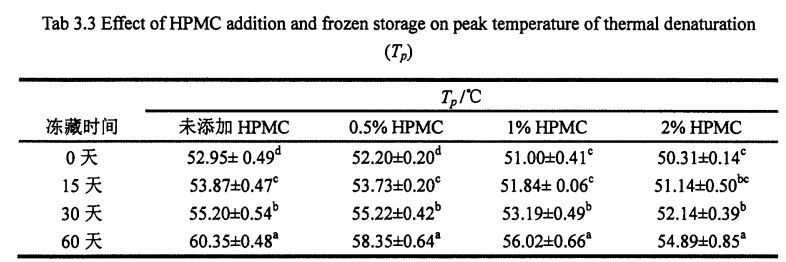
Xusuusin: Xarfaha yar-yar ee ugu hooseeya ee isku midka ah waxay muujinayaan farqi weyn (p <0.05) Waxaa la rumeysan yahay in miyir sare ay ka dhigan tahay in moteluquic-ka motepobic waxayna ka qeybqaataa geedi socodka 'protein molilaule' oo ah molecule [1231]. Therefore, more hydrophobic groups in gluten were exposed during freezing, and HPMC could effectively stabilize the molecular conformation of gluten.
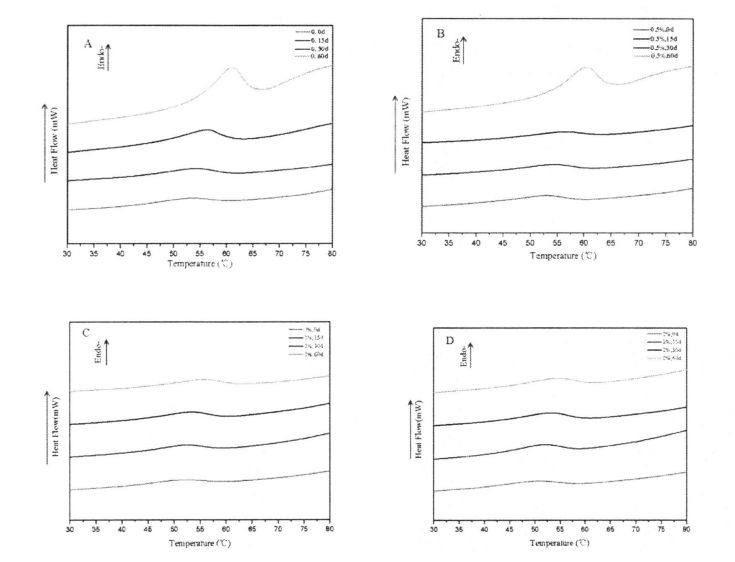
Fig 3.2 Typical DSC thermograms of gluten proteins with 0%HPMC(A);with O.5%HPMC(B); with 1%HPMC(C);with 2%HPMC(D)after different time of frozen storage,from 0d to 60d indicated from the lowest curve to the highest one in each graph. Note: A is the DSC curve of wheat gluten without adding HPMC; B waa isugeynta qalooca O. DSC ee qamadiga gluten oo leh 5% HPMC; C is the DSC curve of wheat gluten with 1% HPMC; D is the DSC curve of wheat gluten with 2% HPMC 3.3.3 Effects of HPMC addition amount and freezing time on free sulfhydryl content (C-SH) Intermolecular and intramolecular covalent bonds are very important for the stability of dough network structure. A disulfide bond (-SS-) is a covalent linkage formed by dehydrogenation of two free sulfhydryl groups (.SH). Glutenin is composed of glutenin and gliadin, the former can form intramolecular and intermolecular disulfide bonds, while the latter can only form intramolecular disulfide bonds [1241] Therefore, disulfide bonds are an intramolecular/intermolecular disulfide bond. habka muhiimka ah ee isku xirka iskuxirka. Compared to adding 0%, O. The C-SH of 5% and 1% HPMC without freezing treatment and the C-SH of gluten after 60 days of freezing have different degrees of increase respectively. Specifically, the face with no HPMC added gluten C. SH increased by 3.74 "mol/g to 8.25 "mol/g, while C.sh, shellfish, with gluten supplemented with 0.5% and 1% HPMC increased by 2.76 "mol/g to 7.25""mol/g and 1.33 "mol/g to 5.66 "mol/g (Fig. 3.3). Zhao, et a1. (2012) found that after 120 days of frozen storage, the content of free thiol groups increased significantly [ 1071. It is worth noting that the C-SH of gluten protein was significantly lower than that of other frozen storage periods when the freezing period was 15 days, which may be attributed to the freezing shrinkage effect of gluten protein structure, which makes the More intermolecular and intramolecular disulfide bonds were locally formed in a shorter freezing time [1161. Wang, et a1. (2014) found that the C-SH of glutenin-rich proteins was also significantly increased after 15 days of freezing. Decreased [1251. However, the gluten protein supplemented with 2% HPMC did not increase significantly except for C-SH, which also decreased significantly at 15 days, with the extension of freezing time.
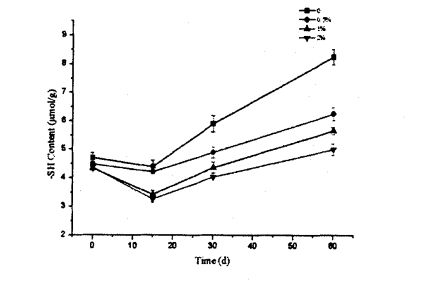
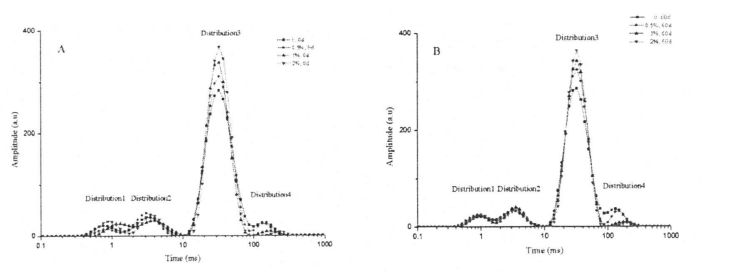
Intaa waxaa sii dheer, dhererka iyo aagga T24 ee qaybinta gluten ee qoorta leh oo leh waxyaabo kaladuwan oo HPMC ah ayaa si weyn uga duwan yahay (oo ay ka koobnaan jireen biyaha xorta ah ayaa si xun loo xiray xaddiga HPMC. This is just the opposite of the Dang distribution. Therefore, this variation rule indicates that HPMC has water holding capacity and converts free water to confined water. However, after 60 days of freezing, the height and area of T24 distribution increased to varying degrees, which indicated that the water state changed from restricted water to free-flowing state during the freezing process. Tan waxaa ugu macquulsan isbedelka ku saabsan isbadalka borotiinka gluten iyo burburka qaybta "lakabka" ee qaab dhismeedka gluten, kaas oo beddelaya gobolka biyaha ku habboon ee ku jira. In kasta oo ay ka kooban tahay biyaha ee ay go'aamiso DSC sidoo kale waxay ku kordhayaan kordhinta waqtiga keydinta qaboojinta, si kastaba ha noqotee, sababta oo ah farqiga u dhexeeya hababka cabbiraadda iyo mabaadi'da astaamaha ee labada, biyaha lagu yareeyo ee biyaha iyo biyaha xorta ah ayaan si buuxda u dhigmin. Loogu talagalay gluten-ka qoyan ee lagu daray 2% HPMC, ka dib 60 maalmood oo ah kaydinta qaboojinta, ee muujinaya in HPMC ay si wax ku ool ah u sii hayn karto guryo biyaha haysta iyo is-dhexgalkeeda oo la yeeshay Gluten. iyo dareeraha xasilloon.
3.3.5 saamaynta Qaddarka isugeynta ee HPMC iyo waqtiga lagu keydiyo qaboojinta ee qaab dhismeedka sare ee borotiinka gluten
Shuruudda iyo magacaabista ayaa ku taxan jadwalka 3.4.
Tab 3.4 Boosaska ugu sarreeya iyo meeleynta qaabdhismeedka sare ayaa asal ahaan ka soo jeeda amide III ee FT-IR Spectra

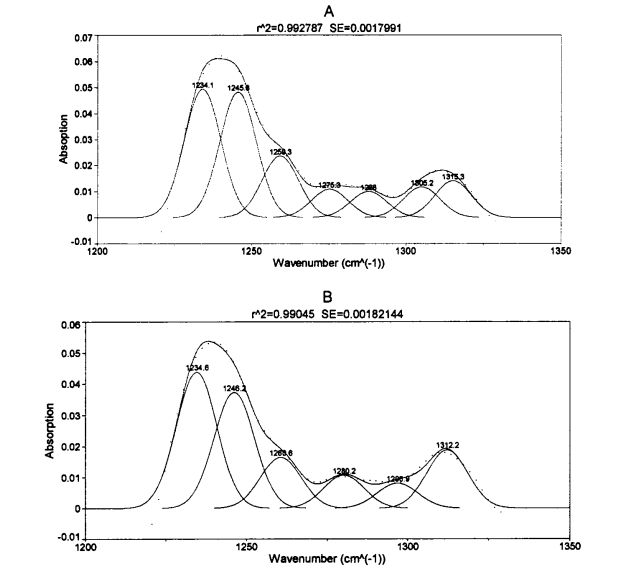
Jaantus
Note: A is the infrared spectrum of wheat gluten protein without adding HPMC for 0 days of frozen storage; B waa cirifka qamadiga ee qamadiga gluten borotiinka kareemka qabow ee 0 maalmood oo leh 2% HPMC
With the prolongation of frozen storage time, the secondary structure of gluten protein with different additions of HPMC changed to different degrees. It can be seen that both frozen storage and addition of HPMC have an effect on the secondary structure of gluten protein. Regardless of the amount of HPMC added, B. The folded structure is the most dominant structure, accounting for about 60%. After 60 days of frozen storage, add 0%, OB Gluten of 5% and 1% HPMC. The relative content of folds increased significantly by 3.66%, 1.87% and 1.16%, respectively, which was similar to the results determined by Meziani et al. (2011) [l33J]. Si kastaba ha noqotee, ma jirin farqi weyn oo lagu jiro inta lagu gudajiray kaydinta qabow ee gluten-ka lagu daro 2% HPMC. In addition, when frozen for 0 days, with the increase of HPMC addition, p. Nuxurka qaraabada ee laalaabtu waxyar bay kordhayeen, gaar ahaan marka lacagta lagu daro ay ahayd 2%, p. The relative content of folds increased by 2.01%. D. Qaab-dhismeedka laalaabsan ayaa loo qaybin karaa is-dhexgal p ah. Isku laalaab (waxaa sababay isku-darka molecules borotiinka borotiinka), antipraallalll p. Laalaaday oo isbarbar dhig p. Saddex qaybood ayaa la laalaabay, wayna adag tahay in la go'aamiyo waxa ku dhacaya inta lagu gudajiro howlaha barafaynta
changed. Some researchers believe that the increase in the relative content of the B-type structure will lead to an increase in the rigidity and hydrophobicity of the steric conformation [41], and other researchers believe that p. The increase in folded structure is due to part of the new β-Fold formation is accompanied by a weakening of the structural strength maintained by hydrogen bonding [421]. β- The increase in the folded structure indicates that the protein is polymerized through hydrophobic bonds, which is consistent with the results of the peak temperature of thermal denaturation measured by DSC and the distribution of transverse relaxation time measured by low-field nuclear magnetic resonance. Diidmada borotiinka. On the other hand, added 0.5%, 1% and 2% HPMC gluten protein α-whirling. The relative content of helix increased by 0.95%, 4.42% and 2.03% respectively with the prolongation of freezing time, which is consistent with Wang, et a1. (2014) found similar results [134]. 0 of gluten without added HPMC. There was no significant change in the relative content of helix during the frozen storage process, but with the increase of the addition amount of freeze for 0 days. There were significant differences in the relative content of α-whirling structures.
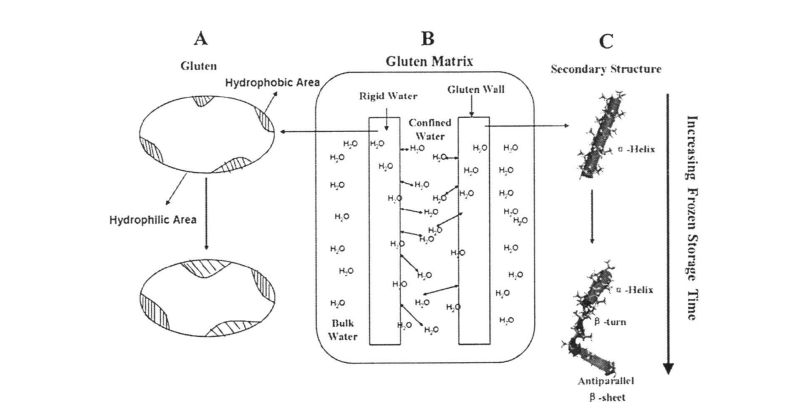
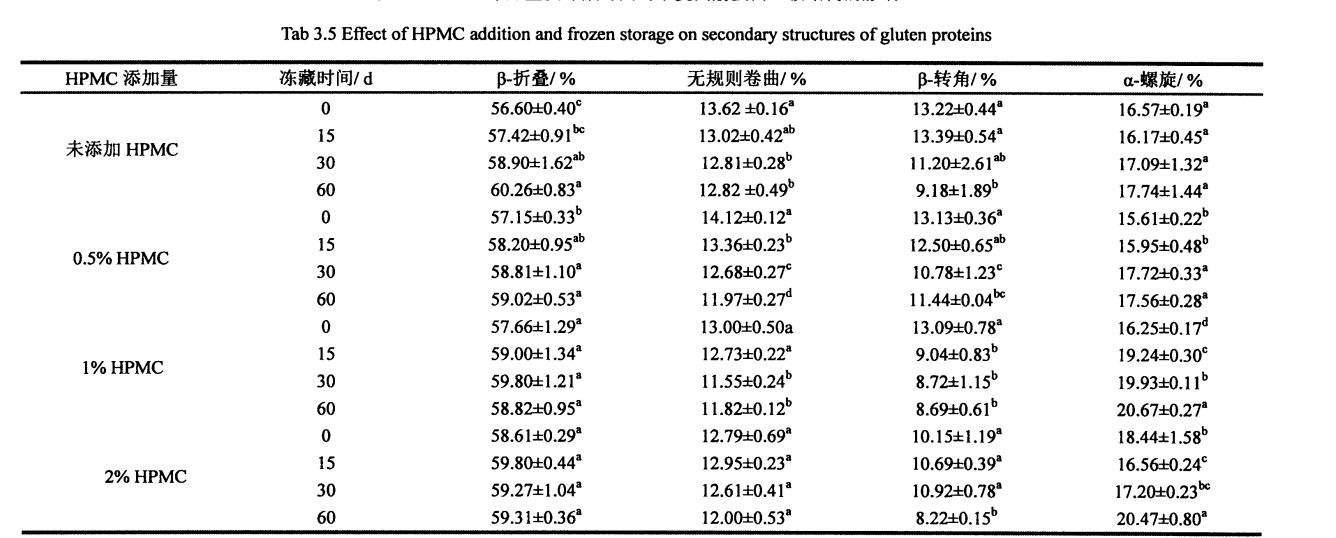
All samples with the extension of freezing time, p. Tusmada qaraabada ee geesaha ayaa si weyn hoos loogu dhigay. This shows that β-turn is very sensitive to freezing treatment [135. 1361], and whether HPMC is added or not has no effect. Wellner, et a1. (2005) proposed that the β-chain turn of gluten protein is related to the β-turn space domain structure of the glutenin polypeptide chain [l 37]. Except that the relative content of random coil structure of gluten protein added with 2% HPMC had no significant change in frozen storage, the other samples were significantly reduced, which may be caused by the extrusion of ice crystals. In addition, when frozen for 0 days, the relative contents of α-helix, β-sheet and β-turn structure of gluten protein added with 2% HPMC were significantly different from those of gluten protein without HPMC. This may indicate that there is an interaction between HPMC and gluten protein, forming new hydrogen bonds and then affecting the conformation of the protein; or HPMC absorbs the water in the pore cavity of the protein space structure, which deforms the protein and leads to more changes between the subunits. close. The increase of the relative content of β-sheet structure and the decrease of the relative content of β-turn and α-helix structure are consistent with the above speculation. During the freezing process, the diffusion and migration of water and the formation of ice crystals destroy the hydrogen bonds that maintain the conformational stability and expose the hydrophobic groups of proteins. In addition, from the perspective of energy, the smaller the energy of the protein, the more stable it is. At low temperature, the self-organization behavior (folding and unfolding) of protein molecules proceeds spontaneously and leads to conformational changes.
Protein molecules include both hydrophilic and hydrophobic groups. Guud ahaan, dusha sare ee borotiinka waxay ka kooban tahay kooxo hydrophiliclic-ka, oo biyo ku xiri kara hydrogen-ka si ay u sameeyaan lakabka biyaha ka-baxa si looga hortago moleekulka molotiinka oo ay ku hayaan xasilloonidooda. Gudaha borotiinka waxaa ku jira kooxo biyo-la'aan ah si loo sameeyo loona dayactiro qaab dhismeedka dugsiga sare iyo jaamacadda ee borotiinka iyada oo loo marayo xoogga biyo-baxa. Diidmada borotiinnada waxaa badanaa la socda soo-gaadhista kooxo hydrophobic oo kordhay biyaha dusha sare.
Tab3.6 Saamaynta isugeynta HPMC iyo keydinta barafka ah ee dusha sare ee saqafka dusha sare ee gluten

Kala duwan oo ka mid ah xarfaha waaweyn ee isla sadarku waxay muujinayaan farqi weyn (<0.05);
Ka dib 60 maalmood oo kayd ah oo barafoobay, ku dar 0%, hydrophobicicity of gluten oo leh 5%, 1% iyo 2% HIPMC, 46.97% iyo 369%, miisaan 3.6). Gaar ahaan, hilibka dusha sare ee borotiinka gluten ah oo aan ku darin HPMC ka dib markii la qaboojiyey muddo 30 maalmood ah ayaa si aad ah u kordhay (p <0%), iyo 2% HPMC-ga ayaa ku daray ka dib markii uu barafoobay 60 maalmood oo biyo-galeenka ah. At the same time, after 60 days of frozen storage, the surface hydrophobicity of gluten protein added with different contents showed significant differences. However, after 60 days of frozen storage, the surface hydrophobicity of gluten protein added with 2% HPMC only increased from 19.749 to 26.995, which was not significantly different from the surface hydrophobicity value after 30 days of frozen storage, and was always lower than other the value of the surface hydrophobicity of the sample. This indicates that HPMC can inhibit the denaturation of gluten protein, which is consistent with the results of DSC determination of the peak temperature of heat deformation. This is because HPMC can inhibit the destruction of protein structure by recrystallization, and due to its hydrophilicity,
3.3.7 saameynta ee xaddidaadda isku-darka ee HPMC iyo waqtiga kaydinta ee qaboojinta ee qaab dhismeedka shabakadda micro-somple of gluten
The continuous gluten network structure contains many pores to maintain the carbon dioxide gas produced by the yeast during the proofing process of the dough. Sidaa darteed, xoogga iyo xasilloonida qaabdhismeedka shabakadda gluten ayaa aad muhiim ugu ah tayada wax soo saarka ugu dambeeya, sida mugga gaar ah, tayo, iwm. Qaab dhismeedka iyo dareenka. From a microscopic point of view, the surface morphology of the material can be observed by scanning electron microscopy, which provides a practical basis for the change of the gluten network structure during the freezing process.
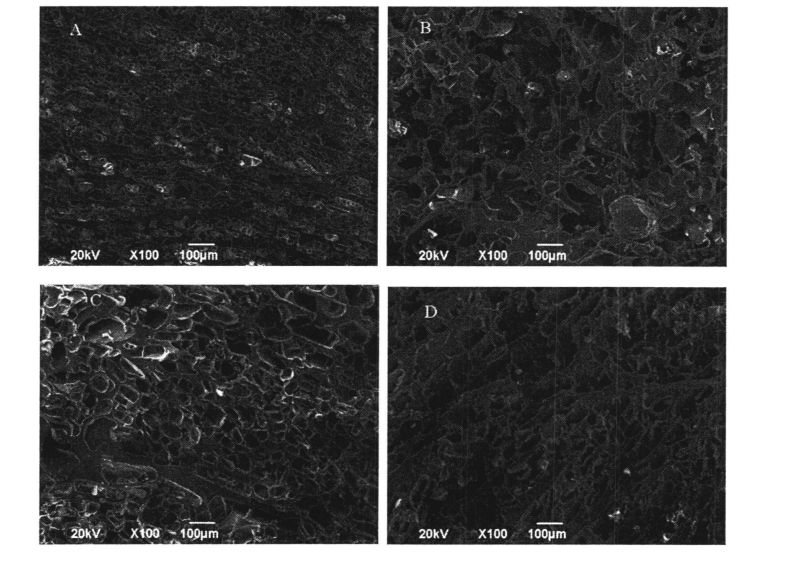
Xusuusin: A waa Michut oo ah shabakadda Gluten iyada oo aan lagu darin HPMC iyo qaboojiyaha 0 maalmood; B waa mikrathur oo ah shabakadda gluten iyada oo aan lagu darin HPMC oo barafoobay 60 maalmood; C is the microstructure of gluten network with 2% HPMC added and frozen for 0 days :D is the gluten network microstructure with 2% HPMC added and frozen for 60 days
4.1 Hordhac
Strechch waa polysaccharide silsilad leh gulukoos sida monomer. key) two types. From a microscopic point of view, starch is usually granular, and the particle size of wheat starch is mainly distributed in two ranges of 2-10 pro (B starch) and 25-35 pm (A starch). From the perspective of crystal structure, starch granules include crystalline regions and amorphous regions (je, non-crystalline regions), and the crystal forms are further divided into A, B, and C types (it becomes V-type after complete gelatinization). Generally, the crystalline region consists of amylopectin and the amorphous region consists mainly of amylose. This is because, in addition to the C chain (main chain), amylopectin also has side chains composed of B (Branch Chain) and C (Carbon Chain) chains, which makes amylopectin appear "tree-like" in raw starch. The shape of the crystallite bundle is arranged in a certain way to form a crystal.
Strechch waa mid ka mid ah qaybaha ugu muhiimsan ee bur, oo ay ka kooban tahay ay u badan tahay ilaa 75% (aasaas qallalan). Isla mar ahaantaana, sidii karbohaydrayt ahaan si weyn u joogaan hadhuudhka, istaarijka ayaa sidoo kale istaarijka ah isha tamar ugu weyn ee tamarta ee cuntada. Nidaamka cajiinka, istaarijka ayaa inta badan loo qaybiyaa oo lagu dhejiyaa qaab dhismeedka shabakadda ee borotiinka gluten. Inta lagu gudajiro howsha iyo kaydinta, istaarisyada badanaa waxay maraan goos goos goos goos ah iyo gabowga.
Among them, starch gelatinization refers to the process in which starch granules are gradually disintegrated and hydrated in a system with high water content and under heating conditions. It can be roughly divided into three main processes. 1) Reversible water absorption stage; before reaching the initial temperature of gelatinization, the starch granules in the starch suspension (Slurry) keep their unique structure unchanged, and the external shape and internal structure basically do not change. Only very little soluble starch is dispersed in the water and can be restored to its original state. 2) The irreversible water absorption stage; as the temperature increases, water enters the gap between the starch crystallite bundles, irreversibly absorbs a large amount of water, causing the starch to swell, the volume expands several times, and the hydrogen bonds between the starch molecules are broken. Waa la fidiyaa oo kiristaagu waa baaba'aan. At the same time, the birefringence phenomenon of starch, that is, the Maltese Cross observed under a polarizing microscope, begins to disappear, and the temperature at this time is called the initial gelatinization temperature of starch. 3) Starch granule disintegration stage; starch molecules completely enter the solution system to form starch paste (Paste/Starch Gel), at this time the viscosity of the system is the largest, and the birefringence phenomenon completely disappears, and the temperature at this time is called the complete starch gelatinization temperature, the gelatinized starch is also called α-starch [141]. When the dough is cooked, the gelatinization of starch endows the food with its unique texture, flavor, taste, color, and processing characteristics.
4.2.1 Qalabka tijaabada ah
Gariiga Gaamanka Binzhou Cuntada Zhongyu, Ltd.; HPMC Aladdin (Shanghai) Reagent Ream, Ltd.;
4.2.2 Qalabka Tijaabada
Q. 200 oo xildhibsiyo iskaanka ah oo kala go 'ah
Wax soo saare
Kooxda Hair
Anhui zhongji zhongjia aaladda sayniska ee CO., LTD.
American ta shirkadaha
American ta shirkadaha
Rigaku wax soo saarkii Co., Ltd.
In this experiment, a rheometer was used instead of a fast viscometer to measure the gelatinization characteristics of starch. Eeg bae et a1. (2014) Qaabka [1571] oo leh wax ka badal yar. The specific program parameters are set as follows: use a plate with a diameter of 40 mill, the gap (gap) is 1000 mm, and the rotation speed is 5 rad/s; I) incubate at 50 °C for 1 min; ii) at 5. C/min heated to 95°C; iii) kept at 95°C for 2.5 min, iv) then cooled to 50°C at 5°C/min; v) lastly held at 50°C for 5 min.
(2) Imtixaanka socodka socodka joogtada ah ee koollada istaarijka
4.2.3.3 Starch Gel Gel Gel Gel
Qaado 2.5 g oo ah amyloid oo ku qas biyo durugsan oo ku jirta cabirkii 1: 2 si aad u sameyso caano istaar ah. Freeze at 18°C for 15 d, 30 d, and 60 d. Add 0.5, 1, 2% HPMC (w/w) to replace starch of the same quality, and other preparation methods remain unchanged. After the freezing treatment is completed, take it out, equilibrate at 4 °C for 4 h, and then thaw at room temperature until it is tested.
A layer of petrolatum was lightly applied to the edge of the starch gel obtained above to avoid water loss during subsequent experiments. Iyadoo loo tixraacayo habka Abebe & Ronda [1601], xayiraad culeys ah oo loo yaqaan 'crapint' oo loo yaqaan 'crapint cuni la' ayaa loo sameeyay si loo go'aamiyo gobolka toosan ee qaaxada (LVR), soo noqnoqodku wuxuu ahaa ka dib markii uu istaago 25 ° C 10 daqiiqo.
Ka dib waqtiga daaweynta ee loo dhiso, sanballada ayaa la soo saaray, gebi ahaanba la dhalaaliyaa, oo lagu qallajiyey foornada 40 ° C 48 h. Finally, it was ground through a 100-mesh sieve to obtain a solid powder sample for use (suitable for XRD testing). Eeg Xe, et a1. (2014) Qaabka loo sameeyo diyaarinta iyo go'aan ka gaarista guryaha thermuundyamic '1611, miisaanka u miisaaman isku-dheellitirka aluminium-ka-qabka yar-yar, oo xir oo ku rid 4 ° C ku dheji qaboojiyaha, oo u dhigma 24 saac. Freeze at 18°C (0, 15, 30 and 60 days). Ku dar 0.5%, 1%, 2% (W / W) HPMC si loo beddelo tayada u dhigma ee istaarijka, iyo hababka kale ee diyaarinta ayaa wali is beddelin. Ka dib markii waqtiga lagu keydiyo qaboojinta ka dib uu dhammaado, soo qaado khafiifka iyo isu dhigma 4 ° C 4 h.
(3) Go'aaminta heerkulka glalaninization iyo isbedelka enhalpy
4.2.3.3 Go'aaminta istaarijka bararka
Qaado 0.1 g oo qallalan, dhulka oo ku dhexjiro tuubbada 50 ml ee biyaha durugsan, si fiican u rux, ka dibna ku dheji 95 ° C si heerkul joogto ah. After 30 min, after gelatinization is complete, take out the centrifuge tube and place it in an ice bath for 10 min for rapid cooling. Finally, centrifuge at 5000 rpm for 20 min, and pour off the supernatant to obtain a precipitate. Swelling Power=precipitation mass/sample mass [163].
4.2.3.3.7 Falanqaynta Xogta iyo Ka Hortagga
4.3 Falanqaynta iyo wadahadalka
4.3.1 Waxyaabaha ay ka kooban yihiin qaybaha aasaasiga ah ee istahaynta qamadiga
According to GB 50093.2010, GB/T 5009.9.2008, GB 50094.2010 (78-s0), the basic components of wheat starch - moisture, amylose/amylopectin and ash content were determined. Natiijooyinka waxaa lagu muujiyey Shaxda 4. 1 ayaa lagu muujiyey.

Cayrinta istaarijka ee ka-fiirsashada ayaa lagu kululeeyaa sicir go'an oo gaar ah si ay u gaaraan istaarijka. After starting to gelatinize, the turbid liquid gradually becomes pasty due to the expansion of starch, and the viscosity increases continuously. Subsequently, the starch granules rupture and the viscosity decreases. When the paste is cooled at a certain cooling rate, the paste will gel, and the viscosity value will further increase. The viscosity value when it is cooled to 50 °C is the final viscosity value (Figure 4.1).
Jadwalka 4.2 wuxuu liis gareeyaa saameynta muujinaya dhowr tilmaamayaal ah oo ah astaamaha istaarijka ee istaarijka, oo ay ku jiraan jawiga ugu wanaagsan ee jaceylka, viscation-ka ugu dambeeya, qiimeynta ugu dambeysa iyo qiimeynta waqtiga isugeynta iyo qaboojinta ee isku-darka. saamaynta guryaha kiimikada ah. The experimental results show that the peak viscosity, the minimum viscosity and the final viscosity of starch without frozen storage increased significantly with the increase of HPMC addition, while the decay value and recovery value decreased significantly. Specifically, the peak viscosity gradually increased from 727.66+90.70 CP (without adding HPMC) to 758.51+48.12 CP (adding 0.5% HPMC), 809.754-56.59 CP (adding 1 %HPMC), and 946.64+9.63 CP (adding 2% HPMC); the minimum viscosity was increased from 391.02+18.97 CP (blank not adding) to 454.95+36.90 (adding O .5% HPMC), 485.56+54.0.5 (add 1% HPMC) and 553.03+55.57 CP (add 2% HPMC); the final viscosity is from 794.62.412.84 CP ( Without adding HPMC) increased to 882.24±22.40 CP (adding 0.5% HPMC), 846.04+12.66 CP (adding 1% HPMC) and 910.884-34.57 CP (adding 2 %HPMC); however, the attenuation value gradually decreased from 336.644-71.73 CP (without adding HPMC) to 303.564-11.22 CP (adding 0.5% HPMC), 324.19±2.54 CP (Add

P (kaydinta la qaboojiyey 0 maalmood) illaa 856.38 ± 16.20 cp (kaydinta la qaboojiyey 60 maalmood); the retrogradation value of starch suspension added with 0.5% HPMC increased from 427 .29±14.50 CP (frozen storage for 0 days) increased to 740.93±35.99 CP (frozen storage for 60 days); the retrogradation value of starch suspension added with 1% HPMC increased from 360.48±41. 39 CP (frozen storage for 0 days) increased to 666.46 ± 21.40 CP (frozen storage for 60 days); while the retrogradation value of starch suspension added with 2% HPMC increased from 357.85 ± 21.00 CP (frozen storage for 60 days). 0 days) increased to 515.51 ± 20.86 CP (60 days frozen).
It can be seen that with the prolongation of freezing storage time, the starch gelatinization characteristics index increased, which is consistent with Tao et a1. F2015) 1. Waxay la jaan qaadayaan natiijooyinka tijaabada, waxay ogaadeen in kororka wareegga wareegga-qaboojiyaha, viscosity-ka ugu sarreeya, viscak-ka ugu dambeeya, iyo qiimaha dib-u-eegista, iyo qiimaha dib-u-fiirinta ee istaarijka istaarijka ah ayaa dhammaantood ku dhacay heerar kala duwan [166J]. Tan waxaa ugu badan sababta oo ah habka lagu keydiyo lagu keydiyo, gobolka amorphphous) ee istaarijka granylues-ka, sidaa darteed ammalphpalsion-ka (oo ka dhalatay in laga joojiyo ganaaxyada, oo ka dhalatay kororka jawiga istaarijka gelatinization, and an increase in the related attenuation value and retrogradation value. However, the addition of HPMC inhibited the effect of ice crystallization on starch structure. Sidaa darteed, cod-gashiga ugu sarreeya, viscosity ugu yar, viscosity-ka ugu dambeeya, qiimaha suuska, qiimaha dib udhaca iyo heerka dib-u-celinta ee istaarijka istaarijka ayaa kordhay iyada oo lagu daro HPMC inta lagu gudajiro kaydinta qabow. increase and decrease sequentially.

4.3.3 Saamaynta Qaddarka isugeynta ee HPMC iyo waqtiga kaydinta ee qaboojiyaha ee xiisaha leh ee xiisaha leh ee korantada
The effect of shear rate on the apparent viscosity (shear viscosity) of the fluid was investigated by the Steady Flow Test, and the material structure and properties of the fluid were reflected accordingly. Jadwalka 4.3 wuxuu liis gareeyaa qiyaasaha isla'egta ee ay ku habboon yihiin, taas oo ah, in la isku darka 'Cleedepent' ee isku-darka ah k iyo tusaha qulqulka ah ee d, iyo sidoo kale saameynta waqtiga dheeriga ah ee HPMC iyo waqtiga aan keydin karin ee ku yaal xudunta kr.


It can be seen from Table 4.3 that all the flow characteristic indices, 2, are less than 1. Therefore, starch paste (whether HPMC is added or whether it is frozen or not) belongs to Pseudoplastic Fluid, and all show shearing Thinning phenomenon (as the shear rate increases, the shear viscosity of the fluid decreases). Intaas waxaa sii dheer, baaritaanka heerka shubka ah wuxuu ka kooban yahay 0.1 s, siday u kala horreeyaan. 1 increased to 100 s ~, and then decreased from 100 sd to O. The rheological curves obtained at 1 sd do not completely overlap, and the fitting results of K, s are also different, so the starch paste is a thixotropic pseudoplastic fluid (whether HPMC is added or whether it is frozen or not). Si kastaba ha noqotee, iyadoo la raacayo isla waqtiga lagu keydiyo qaboojiyaha, oo la kordhiyo kororka HPMC, farqiga u dhexeeya natiijooyinka ku habboon ee labada baaritaan ee labada baarista ah ayaa si tartiib tartiib ah u soo daraya HPMC oo ka dhigaya qaabdhismeedka istaarijka. It remains relatively stable under the action and reduces the "thixotropic ring"
However, with the prolongation of freezing storage time, the values of K and n increased to different degrees, among which the value of K increased from 78.240 ± 1.661 Pa·sn (unadded, 0 days) to 95.570 ± 1, respectively. 2.421 Pa·sn (no addition, 60 days), increased from 65.683±1.035 Pa ·S n (addition of O. 5% HPMC, 0 days) to 51.384±1.350 Pa ·S n (Add to 0.5% HPMC, 60 days), increased from 43.122±1.047 Pa ·sn (adding 1% HPMC, 0 days) to 56.538±1.378 Pa ·sn (adding 1% HPMC, 60 days) ), and increased from 13.926 ± 0.330 Pa ·sn (adding 2% HPMC, 0 days) to 16.064 ± 0.465 Pa ·sn (adding 2% HPMC, 60 days); 0.277 ± 0.011 (without adding HPMC, 0 days) rose to O. 334±0.014 (no addition, 60 days), increased from 0.310±0.009 (0.5% HPMC added, 0 day) to 0.336±0.014 (0.5% HPMC added, 60 days), from 0.323 ± 0.013 (add 1% HPMC, 0 days) to 0.340 ± 0.013 (add 1% HPMC, 60 days), and from 0.431 ± 0.013 (add 1% HPMC, 60 days) 2% HPMC, 0 days) to 0.404+0.020 (add 2% HPMC, 60 days). By comparison, it can be found that with the increase of the addition amount of HPMC, the change rate of K and Knife value decreases successively, which shows that the addition of HPMC can make the starch paste stable under the action of shearing force, which is consistent with the measurement results of starch gelatinization characteristics. joogto ah.
4.3.4 saamaynta qaddarka isugeynta ee HPMC iyo waqtiga lagu keydiyo ee qaboojiya ee vancoelalcity ee istaarch
Meelmarinta soo noqnoqda ee firfircoon ayaa si wax ku ool ah u muujin kara muuqaalka muuqaalka maaddada, iyo istaarijka koollada, tan waxaa loo isticmaali karaa in lagu garto xoogga jel (xoogga jel). Figure 4.3 shows the changes of storage modulus/elastic modulus (G') and loss modulus/viscosity modulus (G") of starch gel under the conditions of different HPMC addition and freezing time.

Jaantuska 4.3 Saamaynta isugeynta HPMC iyo kaydinta qaboojiyaha ah ee kudhaca mossis-ka iyo viscous moschch kootada
The swelling ratio of starch can reflect the size of starch gelatinization and water swelling, and the stability of starch paste under centrifugal conditions. As shown in Figure 4.4, for starch without frozen storage, with the increase of HPMC addition, the swelling force of starch increased from 8.969+0.099 (without adding HPMC) to 9.282- -L0.069 (adding 2% HPMC), which shows that the addition of HPMC increases the swelling water absorption and makes starch more stable after gelatinization, which is consistent with the gabagabada astaamaha istaarta ee istaarta. However, with the extension of frozen storage time, the swelling power of starch decreased. Compared with 0 days of frozen storage, the swelling power of starch decreased from 8.969-a:0.099 to 7.057+0 after frozen storage for 60 days, respectively. .007 (no HPMC added), reduced from 9.007+0.147 to 7.269-4-0.038 (with O.5% HPMC added), reduced from 9.284+0.157 to 7.777 +0.014 (adding 1% HPMC), reduced from 9.282+0.069 to 8.064+0.004 (adding 2% HPMC). The results showed that the starch granules were damaged after freezing storage, resulting in the precipitation of part of the soluble starch and centrifugation. Therefore, the solubility of starch increased and the swelling power decreased. In addition, after freezing storage, starch gelatinized starch paste, its stability and water holding capacity decreased, and the combined action of the two reduced the swelling power of starch [1711]. On the other hand, with the increase of HPMC addition, the decline of starch swelling power gradually decreased, indicating that HPMC can reduce the amount of damaged starch formed during freezing storage and inhibit the degree of starch granule damage.
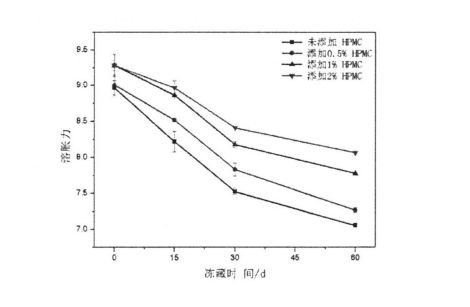
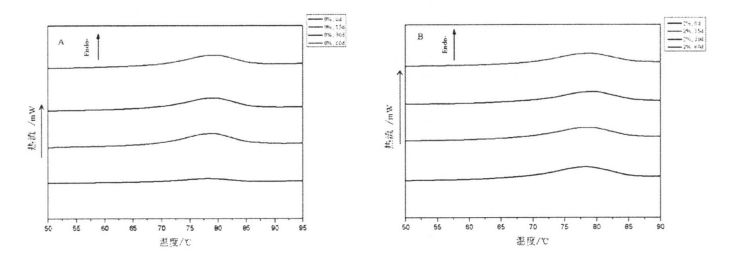
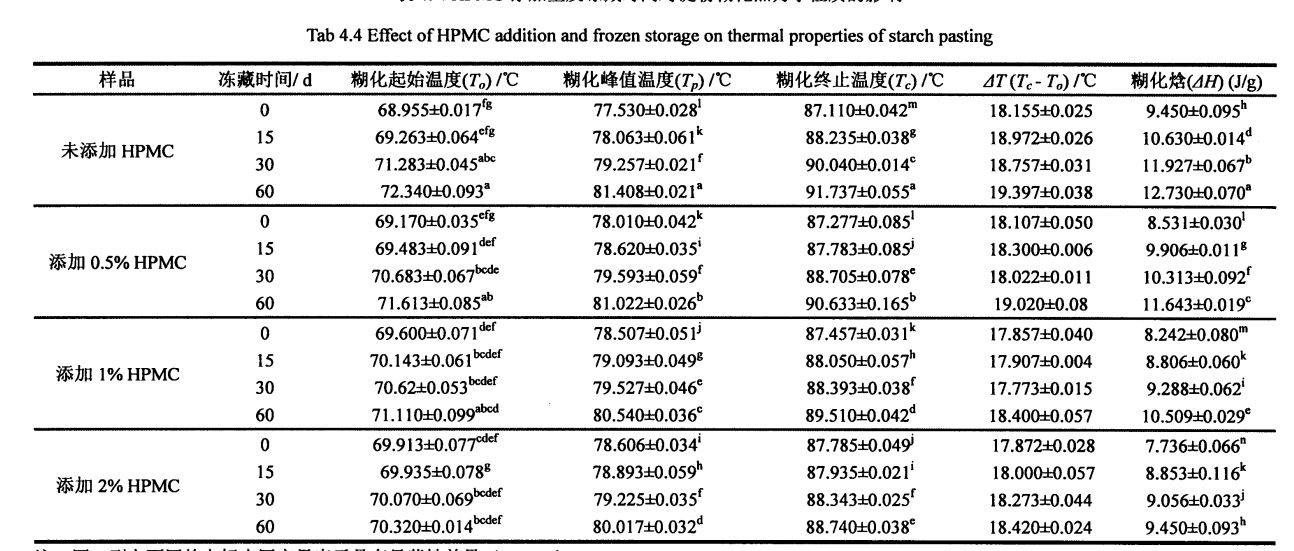
4.3.7 saamaynta isku-darka I-IPMC iyo waqtiga lagu nadiifiyo ee lagu nadiifiyo ee qaraabada qaraabada ah ee istaarijka
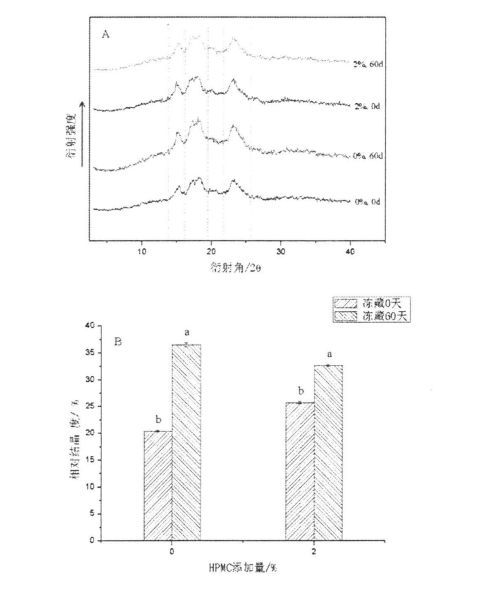
Note: A is x. Qaababka raajada-raajada; B waa ciribtirka qaraabada istaarijka ka dhasha istaarijka;
Cutubka 5 Saamaynta DPMC ee HPMC ee HPMC ee heerka badbaadada khamiirka iyo waxqabadka halsano ee ka hooseeya xaaladaha kaydinta qaboojinta
Yeast has a wide range of applications in fermented flour products (sourdough is obtained by natural fermentation, mainly lactic acid bacteria), it can use the hydrolyzed product of starch in the dough - glucose or maltose as a carbon source, under aerobic conditions, using Substances produce carbon dioxide and water after respiration. Kaarboon-ka dioxide la soo saaray waxay ka dhigi kartaa cajiinka jilicsan, oo jilicsan oo weyn. At the same time, the fermentation of yeast and its role as an edible strain can not only improve the nutritional value of the product, but also significantly improve the flavor characteristics of the product. Therefore, the survival rate and fermentation activity of yeast have an important impact on the quality of the final product (specific volume, texture, and flavor, etc.) [175].
In the case of frozen storage, yeast will be affected by environmental stress and affect its viability. Marka heerka qaboojiyaha uu aad u sarreeyo, biyaha nidaamka ayaa si dhakhso leh u burburin doona oo kordhin doona cadaadiska osmotic-ka osmotic ee khamiirka, taasoo keenta unugyada inay biyo lumiyaan; marka heerka qaboojiyaha uu aad u sarreeyo. Haddii ay aad u yar tahay, kiristaalaha barafka ayaa noqon doona mid aad u ballaaran oo khamiirka waa la tuujiyaa oo derbiga unuggu wuu dhaawici doonaa; both will reduce the survival rate of the yeast and its fermentation activity. In addition, many studies have found that after the yeast cells are ruptured due to freezing, they will release a reducing substance-reduced glutathione, which in turn reduces the disulfide bond to a sulfhydryl group, which will eventually destroy the network structure of gluten protein, resulting in a decrease in the quality of pasta products [176-177].
5.2.1 Qalabka tijaabada ah iyo aaladaha
3m si adag filim adag oo kony ah
BDS. 200 Inverted Biological Microscope
Wax soo saare
Qalabka daahirinta ee Janiangsu Townjman ee CO., LTD.
Anhui zhongji zhongjia aaladda sayniska ee CO., LTD.
Weigh 3 g of active dry yeast, add it to a sterilized 50 mL centrifuge tube under aseptic conditions, and then add 27 mL of 9% (w/V) sterile saline to it, shake it up, and prepare 10% (w/w) yeast broth. Kadib, si dhakhso ah u dhaqaaq. Store in a refrigerator at 18°C. 15 D, 30 D, iyo 60 d oo kaydinta barafka ah, sanballada ayaa loo soo saaray si loo baaro. Add 0.5%, 1%, 2% HPMC (w/w) to replace the corresponding percentage of active dry yeast mass. In particular, after the HPMC is weighed, it must be irradiated under an ultraviolet lamp for 30 minutes for sterilization and disinfection.
Weigh 1 g of dough, add it to a test tube with 9 mL of sterile normal saline according to the requirements of the aseptic operation, shake it fully, record the concentration gradient as 101, and then dilute it into a series of concentration gradients until 10'1. Draw 1 mL of dilution from each of the above tubes, add it to the center of the 3M yeast rapid count test piece (with strain selectivity), and place the above test piece in a 25°C incubator according to the operating requirements and culture conditions specified by 3M. 5 d, take out after the end of the culture, first observe the colony morphology to determine whether it conforms to the colony characteristics of yeast, and then count and microscopically examine [179]. Muunad kasta ayaa lagu celiyay seddex jeer.
The alloxan method was used to determine the glutathione content. The principle is that the reaction product of glutathione and alloxan has an absorption peak at 305 nl. Habka go'aaminta qaaska ah: Pipette 5 ML oo ah xalka khamiirka 10 ml oo ah 3000 rpm oo ah 10 ml oo ka mid ah 0.1 m, oo si fiican u kala saar 0.2 m ph 7.1 m it, mix well, let stand for 6 min, and immediately add 1 M, NaOH The solution was 1 mL, and the absorbance at 305 nm was measured with a UV spectrophotometer after thorough mixing. The glutathione content was calculated from the standard curve. Each sample was paralleled three times.
Experimental results are presented as 4-standard deviation of the mean, and each experiment was repeated at least three times. Falanqaynta kala duwanaanshaha waxaa lagu sameeyay iyadoo la adeegsanayo SPSs, iyo heerka muhiimka ah waxay ahayd 0.05. U adeegso asalka si aad sawirro u sawirto.
5.3.1 Saamaynta Qaddarka isugeynta ee HPMC iyo waqtiga kaydinta ee qaboojiyaha ee cajiinka ee dhajinta

As shown in Figure 5.1, when frozen for 0 days, with the increase in the amount of HPMC added, the proofing height of the dough increased from 4.234-0.11 cm to 4.274 cm without adding HPMC. -0.12 cm (0.5% HPMC added), 4.314-0.19 cm (1% HPMC added), and 4.594-0.17 cm (2% HPMC added) This may be mainly due to HPMC Addition changes the properties of the dough network structure (see Chapter 2). However, after being frozen for 60 days, the proofing height of the dough decreased to varying degrees. Gaar ahaan, dhererka caddeynta ee cajiinka oo aan laga yareyn HPMC ayaa laga yareeyay 4.234-0.1111 cm (qaboojinta 0.18 + 0.15 cm (60 maalmood); the dough added with 0.5% HPMC was reduced from 4.27+0.12 cm (frozen storage for 0 days) to 3.424-0.22 cm (frozen storage for 0 days). 60 days); the dough added with 1% HPMC decreased from 4.314-0.19 cm (frozen storage for 0 days) to 3.774-0.12 cm (frozen storage for 60 days); while the dough added with 2% HPMC woke up. The hair height was reduced from 4.594-0.17 cm (frozen storage for 0 days) to 4.09-±0.16 cm (frozen storage for 60 days). Waxaa lagu arki karaa in kororka lacagta lagu daro ee HPMC, heerka hoos udhaca ee dhererka caddeynta ee cajiinka si tartiib tartiib ah ayuu u yaraanayaa. This shows that under the condition of frozen storage, HPMC can not only maintain the relative stability of the dough network structure, but also better protect the survival rate of yeast and its fermentation gas production activity, thereby reducing the quality deterioration of fermented noodles.
Marka laga hadlayo kaydinta barafoobay, maadaama biyaha la qaboojiyey ee nidaamka cajiinka loo beddelo crystals baraf ah, cadaadiska osmotic ee ka baxsan unugyada khamiirka ah waa la kordhiyaa, si ay udgoonnada khamiirka iyo qaabdhismeedka khamiirka ee culeyska ah. When the temperature is lowered or kept at low temperature for a long time, a small amount of ice crystals will appear in the yeast cells, which will lead to the destruction of the cell structure of the yeast, the extravasation of the cell fluid, such as the release of the reducing substance - glutathione, or even complete death; Isla mar ahaantaana, khamiirka ka hooseeya walbahaarka deegaanka, nashaadkeeda dheef-shiid kiimikaad ayaa la dhimi doonaa, iyo qaar ka mid ah faasasyada ayaa la soo saari doonaa, kaas oo yareyn doona waxqabadka gaaska ee khamiirka khamiirka.
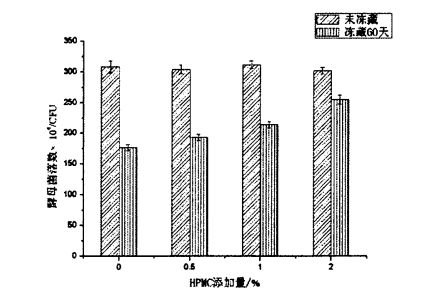
Saamaynta Bishii-Bogga52
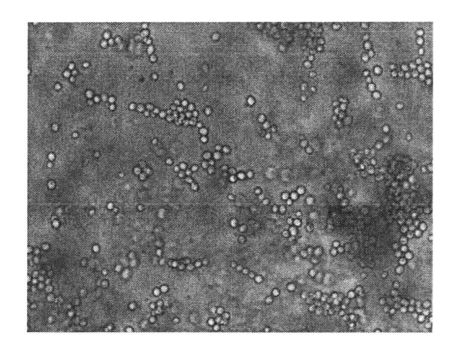
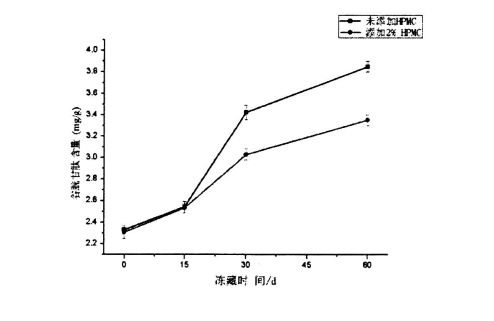
As shown in Figure 5.4, the glutathione content increased regardless of whether HPMC was added or not, and there was no significant difference between the different addition amounts. Tani waxay noqon kartaa sababta oo ah qaar ka mid ah khamiirka firfircoon ee loo isticmaalo in lagu sameeyo cajiinka ayaa leh iska caabbinta walaaca fekerka oo liita iyo dulqaad. Under the condition of low temperature freezing, the cells die, and then glutathione is released, which is only related to the characteristics of the yeast itself. It is related to the external environment, but has nothing to do with the amount of HPMC added. Therefore, the content of glutathione increased within 15 days of freezing and there was no significant difference between the two. Si kastaba ha noqotee, iyadoo la kordhiyo kordhinta waqtiga qaboojinta, kororka dareenka qanjirka, oo ay ku kacayso kororka bucbiga ee HPMC oo aan HPMC ka kordhay 2.8514-0.0Ma.01 MG / G (Guntooska la qaboojiyey); In kasta oo khamiirka lagu daray 2% HPMC, waxa ku jira sanqadha ay ka kooban tahay 2.307 + 0 This further indicated that HPMC could better protect yeast cells and reduce the death of yeast, thereby reducing the content of glutathione released to the outside of the cell. This is mainly because HPMC can reduce the number of ice crystals, thereby effectively reducing the stress of ice crystals to yeast and inhibiting the increase of extracellular release of glutathione.
Yeast is an indispensable and important component in fermented flour products, and its fermentation activity will directly affect the quality of the final product. Tijaabadadan, saameynta difaaca ee HPMC ee khamiirka nidaamka cajiinka ee barafka ah waxaa lagu qiimeeyay iyadoo lagu barto saameynta kala-soocidda HPMC ee kala duwan ee HPMC, nambarka jihada khamiirka, iyo waxyaabaha Glutacelluarl Glutakon cajiinka la qaboojiyey. Through experiments, it was found that the addition of HPMC can better maintain the fermentation activity of the yeast, and reduce the degree of decline in the proofing height of the dough after 60 days of freezing, thus providing a guarantee for the specific volume of the final product; in addition, the addition of HPMC effectively The decrease of yeast survival number was inhibited and the increase rate of reduced glutathione content was reduced, thereby alleviating the damage of glutathione to dough network structure. This suggests that HPMC can protect yeast by inhibiting the formation and growth of ice crystals.
Waqtiga Post: Oct-08-2022







